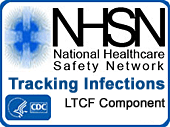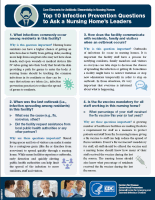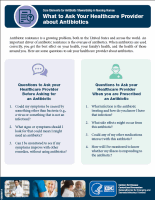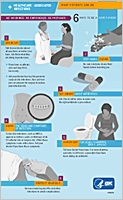Resident Information
Residents and advocates of nursing homes, assisted living facilities and other long-term care facilities should be aware that people have a higher chance of getting an infection when living at one of these facilities than they likely would at home. This page contains links to information and resources about infections that can be acquired when receiving care in nursing homes and assisted living facilities.
Common Infections and Bacteria in LTCFs
Carbapenem-resistant Enterobacteriaceae (CRE)
Carbapenem-resistant Enterobacteriaceae (CRE): are a family of germs that are difficult to treat because they have high levels of resistance to antibiotics. Klebsiella species and Escherichia coli (E. coli) are examples of Enterobacteriaceae, a normal part of the human gut bacteria that can become carbapenem-resistant.
Patients whose care requires devices like ventilators (breathing machines), urinary (bladder) catheters, or intravenous (vein) catheters, and patients who are taking long courses of certain antibiotics are most at risk for CRE infections. For more information go to CRE in healthcare settings.
Clostridium difficile (C.diff)
C. diff [PDF- 172 KB]: [klo–strid–ee–um dif–uh–seel] is a bacterium that causes an inflammation of the colon; this condition is called colitis. Diarrhea and fever are the most common symptoms of Clostridium difficile infection. Overuse of antibiotics is the most important risk for getting Clostridium difficile infection. [Clostridium difficile is also called C. difficile, C. diff, and CDI (Clostridium difficile infection), CDAD (Clostridium difficile-associated disease)]. For more information go to C.difficile infection.
Catheter-Associated Urinary Tract Infection (CAUTI)
CAUTI [PDF -225 -KB]: An indwelling urinary catheter is a drainage tube that is inserted into the urinary bladder through the urethra, which is left in place and connected to a closed collection system. A catheter-associated urinary tract infection (CAUTI) occurs when germs (usually bacteria) enter the urinary tract through the urinary catheter and cause infection. CAUTIs have been associated with increased morbidity, mortality, healthcare costs, and length of stay. For more information go to CAUTI infections.
Influenza
Influenza: Influenza is primarily a community-based infection that is transmitted in households and community settings. Healthcare-associated influenza infections can occur in any healthcare setting including long-term care and are most common when influenza is also circulating in the community. Therefore, influenza prevention measures should be implemented in all healthcare settings. For more information see key facts about influenza.
What You Should Know and Do this Flu Season If You Are 65 Years and Older Fact Sheet.
Methicillin-resistant Staphylococcus aureus (MRSA)
MRSA [PDF – 215 KB]: Methicillin-resistant Staphylococcus aureus (MRSA) is a type of staph bacteria that is resistant to certain antibiotics called beta-lactams. These antibiotics include methicillin and other more common antibiotics such as oxacillin, penicillin, and amoxicillin. In the community, most MRSA infections are skin infections. More severe or potentially life-threatening MRSA infections occur most frequently among patients in Healthcare Settings. [Methicillin-resistant Staphylococcus aureus is also called MRSA]. For more information go to MRSA in healthcare settings.
Norovirus
Norovirus [PDF – 333 KB]: Noroviruses are a group of viruses that cause gastroenteritis [gas-trō-en-ter-ī-tis] in people. Gastroenteritis is an inflammation of the lining of the stomach and intestines, causing an acute onset of severe vomiting and diarrhea. Norovirus illness is usually brief in people who are otherwise healthy. Young children, the elderly, and people with other medical illnesses are most at risk for more severe or prolonged infection. Like all viral infections, noroviruses are not affected by treatment with antibiotics. For more information visit CDC’s Norovirus website.
Resources for Understanding Long-Term Care
- Page last reviewed: March 16, 2016
- Page last updated: February 16, 2017
- Content source:




 ShareCompartir
ShareCompartir





